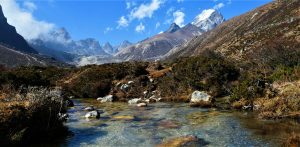Many species in mountains have to choose between higher temperatures or decreased oxygen levels

Photo credit: Dean Jacobsen, University of Copenhagen
As a result of global warming many species are currently shifting altitudinal distribution in mountain areas. Even though most move to higher altitudes, there are large differences among species, and some even shift downward to lower altitudes. A recently published paper in the acclaimed journal Frontiers in Ecology and the Environment from the Ecological Society of America presents a theory that might contribute to our understanding of these differences among species.
Due to climate warming species distribution models predict upwards shifts of altitudinal ranges. However, observed range shifts vary grossly among species. Often upward shifts appear to overshoot, or lag behind temperature-based model predictions. Also downward shifts, although rather counterintuitive in a climate warming perspective, are observed. These differences among species are interesting, and have usually been explained by differences in dispersal capacities and biotic interactions may contribute to differences between expected and observed range shifts.
In a paper recently published in the acclaimed journal Frontiers in Ecology and the Environment from the Ecological Society of America, Dean Jacobsen, Freshwater Biological Section, presents a completely new theory that might contribute to our understanding of these puzzling differences in altitudinal shifts among species, at least for ectothermic (ie so-called cold-blooded) aquatic animals.
Read the article in Frontiers: https://esajournals.onlinelibrary.wiley.com/doi/full/10.1002/fee.2161